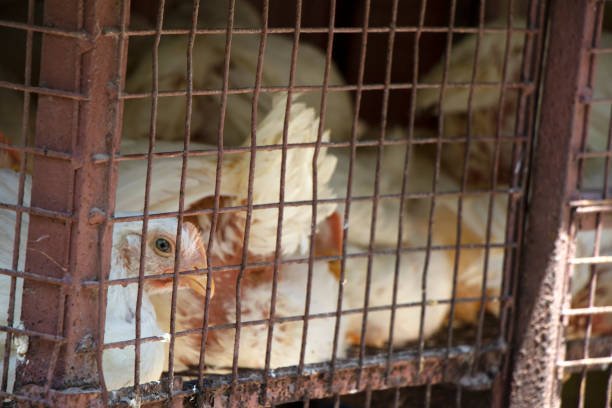On this page, we explore four examples of inhumane farming methods.
Inhumane Farming Methods: Four Examples that Call for Ethical Reform
The global demand for animal products has led to industrial farming methods that prioritize efficiency and productivity over animal welfare. While these practices may make economic sense in the short term, they often come at the cost of ethical considerations.
Four Examples of Inhumane Farming Methods
Below are four examples of inhumane farming methods that call for urgent attention and reform:
1. Battery Cages for Egg-Laying Hens

What it is: Battery cages are small wire cages where egg-laying hens are kept. Each cage can house multiple birds, but the space is often so cramped that the hens cannot stretch their wings, move around freely, or perform natural behaviors like dust-bathing or nesting.
Why it’s inhumane: The confined space leads to a range of health issues, including feather loss, weakened bones, and a higher susceptibility to disease. The inability to engage in natural behaviors can also lead to psychological stress.
Alternatives: Free-range, pasture-raised, or barn systems allow hens more space to move and the freedom to engage in natural behaviors.
2. Gestation Crates for Sows
What it is: Gestation crates are narrow metal enclosures where pregnant pigs are confined during their pregnancy. These crates are often so small that the sow cannot turn around, lie down comfortably, or interact with other pigs.
Why it’s inhumane: Like battery cages, the confined space results in physical and psychological stress, increasing the likelihood of illness and decreasing overall well-being.
Alternatives: Group housing systems where sows are kept in pens allow for social interaction and more freedom of movement, improving both physical and psychological health.
3. Veal Crates
What it is: Veal crates are used to confine young male calves who are byproducts of the dairy industry. These crates are small and narrow, restricting the calf’s movement to a minimal range, often for their entire lives.
Why it’s inhumane: The calves are usually separated from their mothers within hours of birth and are fed a diet low in iron to produce pale-colored veal. The confinement and lack of proper nutrition lead to significant health issues, including weakened bones and anemia.
Alternatives: Raising calves in a group housing system with a more balanced diet and the ability to move freely would be a more ethical approach.
4. Forced Molting
What it is: Forced molting is a practice commonly used in the poultry industry to extend the egg-laying cycle of hens. This is achieved by withholding food, water, or both for an extended period to induce a state of dormancy in the hens.
Why it’s inhumane: Forced molting leads to significant stress and health issues for the hens, including a weakened immune system, feather loss, and in some cases, death.
Alternatives: Natural molting or using selective breeding methods to encourage longer laying cycles without inducing stress can be more humane options.
The need for reform in farming practices is clear. While progress has been made in some areas, these inhumane methods persist, often hidden from public view. Implementing humane alternatives is not just an ethical imperative but could also result in healthier, higher-quality animal products. As consumers become increasingly aware of animal welfare issues, the demand for ethically-produced food is likely to rise, making it economically sensible for producers to adopt more humane practices.

